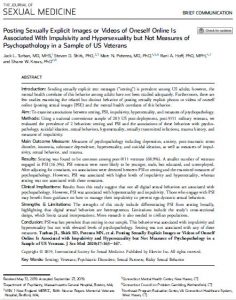Mental Health
Posting Sexually Explicit Images or Videos of Oneself Online
 Full Article Title: Posting Sexually Explicit Images or Videos of Oneself Online Is Associated With Impulsivity and Hypersexuality but Not Measures of Psychopathology in a Sample of US Veterans
Full Article Title: Posting Sexually Explicit Images or Videos of Oneself Online Is Associated With Impulsivity and Hypersexuality but Not Measures of Psychopathology in a Sample of US Veterans
Open Access: No
Abstract
Introduction: Sending sexually explicit text messages (“sexting”) is prevalent among US adults; however, the mental health correlates of this behavior among adults have not been studied adequately. Furthermore, there are few studies examining the related but distinct behavior of posting sexually explicit photos or videos of oneself online (posting sexual images [PSI]) and the mental health correlates of this behavior.
Aim: To examine associations between sexting, PSI, impulsivity, hypersexuality, and measures of psychopathology.
Methods: Using a national convenience sample of 283 US post-deployment, post-9/11 military veterans, we evaluated the prevalence of 2 behaviors: sexting and PSI and the associations of these behaviors with psychopathology, suicidal ideation, sexual behaviors, hypersexuality, sexually transmitted infections, trauma history, and measures of impulsivity.
Main Outcome Measure: Measures of psychopathology including depression, anxiety, post-traumatic stress disorder, insomnia, substance dependence, hypersexuality, and suicidal ideation, as well as measures of impulsivity, sexual behavior, and trauma.
Results: Sexting was found to be common among post-9/11 veterans (68.9%). A smaller number of veterans engaged in PSI (16.3%). PSI veterans were more likely to be younger, male, less educated, and unemployed. After adjusting for covariates, no associations were detected between PSI or sexting and the examined measures of psychopathology. However, PSI was associated with higher levels of impulsivity and hypersexuality, whereas sexting was not associated with these measures.
Clinical Implications: Results from this study suggest that not all digital sexual behaviors are associated with psychopathology. However, PSI was associated with hypersexuality and impulsivity. Those who engage with PSI may benefit from guidance on how to manage their impulsivity to prevent ego-dystonic sexual behaviors.
Strengths & Limitations: The strengths of this study include differentiating PSI from sexting broadly, highlighting that digital sexual behaviors are heterogeneous. Limitations include the study’s cross-sectional design, which limits causal interpretations. More research is also needed in civilian populations.
Conclusion: PSI was less prevalent than sexting in our sample. This behavior was associated with impulsivity and hypersexuality but not with elevated levels of psychopathology. Sexting was not associated with any of these measures.
